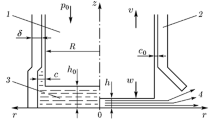Abstract
The solution of the hydrodynamic problem of a non-Newtonian medium flow squeezed by two approaching parallel disks, which was previously obtained by Scott, is used to determine the strain and ignition parameters of explosive specimens in drop tests at the lower threshold of their sensitivity.
Similar content being viewed by others
REFERENCES
A. V. Dubovik and V. K. Bobolev, Impact Sensitivity of Liquid Explosives [in Russian], Nauka, Moscow (1978).
O. F. Shlenskii, E. S. Sokolov-Borodkin, and V. N. Chechko, “Possibility of initiating an explosion of condensed energetic materials by mechanical activation of nucleation processes upon impact,” Combust. Expl. Shock Waves, 37, No.1, 106–120 (2001).
A. V. Dubovik, “Estimating impact breakup and initiation parameters of condensed explosives,” Combust. Expl. Shock Waves, 35, No. 2, 88–95 (1999).
A. V. Dubovik, “Numerical simulation of the mechanical initiation of liquid explosive systems,” Combust. Expl. Shock Waves, 35, No. 3, 309–316 (1999).
A. V. Belik, V. A. Potemkin, and S. N. Sluka, “Shock sensitivity analysis of organic explosives,” Combust. Expl. Shock Waves, 35, No. 5, 562–567 (1999).
J. R. Scott, “Hydrodynamics of the polymer melting flow in the at chanals,” Inst. Rubber Industry Trans., 7, No. 1, 169–175 (1931).
P. J. Lieder and R. B. Bird, “Squeezing flow between parallel disks. Part I. Theoretical analysis,” Ind. Eng. Chem. Fundam. 13 336–345 (1974).
Z. Tadmor and C. G. Gogos, Principles of Polymer Processing, Wiley (1979).
K. K. Andreev and A. F. Belyaev, Theory of Explosives [in Russian], Oborongiz, Moscow (1960).
O. F. Shlenskii and E. S. Sokolov-Borodkin, “Effect of mechanical actions on attainable overheating and boiling conditions of metastable fluids,” Teplofiz. Vys. Temper., 17, No. 1, 106–112 (1999).
O. F. Shlenskii, “Effect of small mechanical actions on the nucleation frequency and rate of thermal decomposition of condensed systems,” Khim. Fiz., 17, No. 7, 95–112 (1998).
A. V. Lykov, Theory of Heat Conduction [in Russian], Vysshaya Shkola, Moscow(1967).
V. P. Skripov, E. N. Sinitsyn, P. A. Pavlov, et al., Thermophysical Properties of Fluids in the Metastable State [in Russian], Atomizdat, Moscow (1980).
Author information
Authors and Affiliations
Rights and permissions
About this article
Cite this article
Shlenskii, O.F., Sokolov-Borodkin, E.S. Application of the Scott Hydrodynamic Model for Analysis of Results of Impact Testing of High-Explosive Specimens. Combustion, Explosion, and Shock Waves 39, 340–347 (2003). https://doi.org/10.1023/A:1023804622253
Issue Date:
DOI: https://doi.org/10.1023/A:1023804622253




